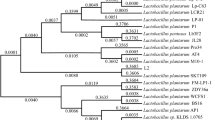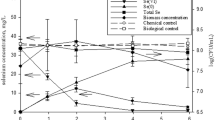Abstract
In this study, the effect of low selenium concentrations on bacteria growth, selenium bioaccumulation, and selenium speciation in Pediococcus acidilactici was investigated. Six different sodium selenite (Na2SeO3) solutions with concentrations of 0, 0.5, 1, 2, 3, and 4 mg/L were added in MRS broth for 24 h. Then, the obtained bacterial pellets were weighed. The contents of total selenium and selenium species in the bacterial pellets were measured via optimized enzymatic hydrolysis and HPLC-ICP-MS. The maximum dried P. acidilactici biomass of 1.44 g/L was achieved by utilizing 1 mg/L Na2SeO3. By increasing sodium selenite concentrations, total selenium contents were significantly increased from 0.14 to 1.45 mg/g dry weight (p < 0.05). The findings indicated that selenium was favorably incorporated into the bacteria protein fraction and mainly formed selenocysteine. Therefore, selenium-enriched lactic acid bacterium P. acidilactici can deliver a less-toxic, more bioavailable selenium source for human and animal nutrition.


Similar content being viewed by others
References
Mrvčić J, Stanzer D, Šolić E, Stehlik-Tomas V. Interaction of lactic acid bacteria with metal ions: opportunities for improving food safety and quality. World J. Microbiol. Biotechnol. 28: 2771–2782 (2012)
Pophaly SD, Singh P, Kumar H, Tomar SK, Singh R. Selenium enrichment of lactic acid bacteria and bifidobacteria: A functional food perspective. Trends Food Sci. Technol. 39: 135–145 (2014)
Balcázar JL, De Blas I, Ruiz-Zarzuela I, Cunningham D, Vendrell D, Múzquiz JL. The role of probiotics in aquaculture. Vet. Microbiol. 114: 173–186 (2006)
Xia SK, Chen L, Liang JQ. Enriched selenium and its effects on growth and biochemical composition in Lactobacillus bulgaricus. J. Agr. Food Chem. 55: 2413–2417 (2007)
Alzate A, Cañas B, Pérez-Munguía S, Hernández-Mendoza H, Pérez-Conde C, Gutiérrez AM, Cámara C. Evaluation of the inorganic selenium biotransformation in selenium-enriched yogurt by HPLC-ICP-MS. J. Agr. Food Chem. 55: 9776–9783 (2007)
Alzate A, Fernández-Fernández A, Perez-Conde M, Gutiérrez A, Cámara C. Comparison of biotransformation of inorganic selenium by Lactobacillus and Saccharomyces in lactic fermentation process of yogurt and kefir. J. Agr. Food Chem. 56: 8728–8736 (2008)
Palomo M, Gutiérrez AM, Pérez-Conde MC, Cámara C, Madrid Y. Se metallomics during lactic fermentation of Se-enriched yogurt. Food Chem. 164: 371–379 (2014)
Yang J, Huang K, Qin S, Wu X, Zhao Z, Chen F. Antibacterial action of selenium-enriched probiotics against pathogenic Escherichia coli. Digest. Dis. Sci. 54: 246–254 (2009)
Araúz ILC, Afton S, Wrobel K, Caruso JA, Corona JFG, Wrobel K. Study on the protective role of selenium against cadmium toxicity in lactic acid bacteria: An advanced application of ICP-MS. J. Hazard. Mater. 153: 1157–1164 (2008)
Biswas S, Ray P, Johnson M, Ray B. Influence of growth conditions on the production of a bacteriocin, pediocin AcH, by Pediococcus acidilactici H. App. Env. Microbiol. 57: 1265–1267 (1991)
Burr G, Gatlin D, Ricke S. Microbial ecology of the gastrointestinal tract of fish and the potential application of prebiotics and probiotics in finfish aquaculture. J. World Aquacult. Soc. 36: 425–436 (2005)
Fernandez B, Savard P, Fliss I. Survival and metabolic activity of pediocin producer Pediococcus acidilactici UL5: Its Impact on intestinal microbiota and Listeria monocytogenes in a model of the human terminal ileum. Microbial. Ecol. 72: 931–942 (2016)
Gatesoupe F-J. Probiotic and formaldehyde treatments of Artemia nauplii as food for larval pollack, Pollachius pollachius. Aquaculture 212: 347–360 (2002)
Attri P, Jodha D, Gandhi D, Chanalia P, Dhanda S. In vitro evaluation of Pediococcus acidilactici NCDC 252 for its probiotic attributes. Int. J. Dairy Technol. 68: 533–542 (2015)
Barros RR, Maria Da Glória SC, Peralta JM, Facklam RR, Teixeira LM. Phenotypic and genotypic characterization of Pediococcus strains isolated from human clinical sources. J. Clin. Microbiol. 39: 1241–1246 (2001)
Mizutani W, Yamasaki R, Lin JJ, Kuki M, Kato G. Pediococcus an unique probiotic we use as a novel GI supplement. Ann. Meet. Jpn. Brd. Vet. Pract.: 3269–3272 (2007)
Altuntas EG, Cosansu S, Ayhan K. Some growth parameters and antimicrobial activity of a bacteriocin-producing strain Pediococcus acidilactici 13. Int. J. Food Microbiol. 141: 28–31 (2010)
Stolz JF, Basu P, Santini JM, Oremland RS. Arsenic and selenium in microbial metabolism. Ann. Rev. Microbiol. 60: 107–130 (2006)
Zhang B, Zhou K, Zhang J, Chen Q, Liu G, Shang N, Qin W, Li P, Lin F. Accumulation and species distribution of selenium in Se-enriched bacterial cells of the Bifidobacterium animalis 01. Food Chem. 115: 727–734 (2009)
Andreoni V, Luischi MM, Cavalca L, Erba D, Ciappellano S. Selenite tolerance and accumulation in the Lactobacillus species. Ann. Microbiol. 50: 77–88 (2000)
Kurek E, Ruszczyńska A, Wojciechowski M, Łuciuk A, Michalska-Kacymirow M, Motyl I, Bulska E. Bio-transformation of selenium in Se-enriched bacterial strains of Lactobacillus casei. Rocz. Panstw. Zakl. Hig. 67: 253–262 (2016)
Barwick M, Maher W. Biotransference and biomagnification of selenium copper, cadmium, zinc, arsenic and lead in a temperate seagrass ecosystem from Lake Macquarie Estuary, NSW, Australia. Marine Env. Res. 56: 471–502 (2003)
Imoto T, Yagishita K. A simple activity measurement of lysozyme. Agr. Bio. Chem. 35: 1154–1156 (1971)
Calomme M, Branden K, Berghe D. Selenium and Lactobacillus species. J. App. Bacteriol. 79: 331–340 (1995)
Rother M. Selenium metabolism in prokaryotes. pp. 457–470. In: Selenium: its molecular biology and role in human health. Hatfield DL, Berry MJ, Gladyshev VN (eds). Springer, New York, USA (2011)
Acknowledgements
This work was financially supported by Sari Agricultural Sciences and Natural Resources University, Sari, Iran.
Author information
Authors and Affiliations
Corresponding author
Ethics declarations
Conflict of interest
The authors declare no conflict of interest.
Rights and permissions
About this article
Cite this article
Kousha, M., Yeganeh, S. & Keramat Amirkolaie, A. Effect of sodium selenite on the bacteria growth, selenium accumulation, and selenium biotransformation in Pediococcus acidilactici . Food Sci Biotechnol 26, 1013–1018 (2017). https://doi.org/10.1007/s10068-017-0142-y
Received:
Revised:
Accepted:
Published:
Issue Date:
DOI: https://doi.org/10.1007/s10068-017-0142-y




